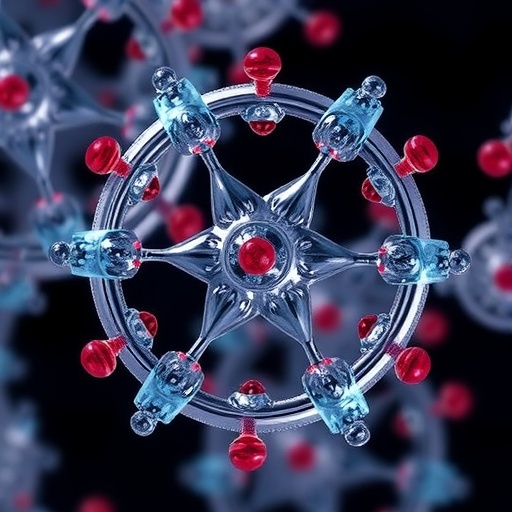In the rapidly evolving field of polymer science, achieving precise control over the mechanical properties of materials remains a formidable challenge. A groundbreaking study conducted by researchers at Shanghai Jiao Tong University has unveiled a novel method for manipulating the dissociation kinetics of supramolecular polymer networks (SPNs), thereby influencing their macroscopic mechanical behavior. By innovatively introducing pseudorotaxane end groups with varying steric hindrance, the team has demonstrated an unprecedented ability to fine-tune the dynamic character of SPNs, heralding new possibilities for the design of smart materials with programmable properties.
Supramolecular polymer networks distinguish themselves from traditional covalent polymeric materials by virtue of their non-covalent crosslinking interactions, which confer remarkable dynamic features including self-healing, stimuli responsiveness, and recyclability. Central to these attributes is the reversible association and dissociation of the crosslinking points, governed by a complex interplay of thermodynamic stability and kinetic rates. Although previous efforts have largely focused on altering interaction strengths to modulate these parameters, such approaches frequently result in a conflation of thermodynamic and kinetic effects, complicating precise control and often demanding complex molecular architectures.
Addressing these limitations, the current research pivots towards leveraging steric hindrance at the molecular level as a kinetic regulator. By varying the bulkiness of pseudorotaxane end-capping groups attached to the crosslinkers within the SPN, the team achieves a wide dynamic range of dissociation rates without significantly altering the intrinsic thermodynamic binding affinities. This strategy permits the tailoring of supramolecular dynamics across six orders of magnitude, with dissociation rate constants as low as 6.1 × 10⁻⁷ s⁻¹, surpassing the control previously attainable via binding strength modulation.
Detailed spectroscopic analyses employing proton nuclear magnetic resonance (^1H NMR) elucidated the kinetic landscape of the crosslinkers. Crosslinker 1, bearing more compact pyrrole end groups, exhibited rapid association and dissociation kinetics considerably faster than crosslinker 2, which incorporated bulkier seven-membered ring structures. Specifically, crosslinker 1’s apparent binding rate constant (k_a) exceeded 2.4 × 10⁻³ s⁻¹, contrasting starkly with the sluggish 4.2 × 10⁻⁷ s⁻¹ observed for crosslinker 2. This vast disparity, approximately 5,760-fold for association and 5,700-fold for dissociation, underscores the critical influence of steric factors in modulating supramolecular dynamics.
This kinetic modulation translated palpably into the rheological properties and mechanical performance of the resultant SPNs. Using dynamic mechanical analysis, SPN-2 crafted with sterically hindered end groups exhibited a broader linear viscoelastic regime, extending beyond 10% strain, and a pronounced elastic plateau spanning a wide frequency range. These features reflect a highly stable network architecture resistant to deformation. Conversely, SPN-1, with minimal steric barriers, showed rapid relaxation behavior and early network failure under applied strain, affirming the functional consequences of accelerated crosslink dissociation.
Tensile testing further illuminated the material advantages imparted by steric control. Despite comparable Young’s moduli indicating similar initial stiffness, SPN-2 dramatically outperformed its counterpart in fracture stress (14.5 vs. 4.1 MPa), ultimate elongation (549.5% vs. 273.5%), and toughness (46.7 vs. 9.4 MJ·m⁻³). Such enhancements reflect the network’s ability to sustain higher loads and endure larger deformations before failure, attributable to the slower supramolecular dissociation kinetics and resultant stable crosslinking environment.
The robustness of SPN-2’s network was further evidenced through chemical challenge experiments. Exposure to triethylamine vapor, which disrupts hydrogen bonding and other recognition interactions, significantly degraded the mechanical properties of SPN-1 but left SPN-2 comparatively unscathed. This resistance exemplifies how sterically hindered end groups provide an effective protective mechanism for maintaining network integrity under potentially destabilizing conditions.
Complementary creep and recovery tests corroborated these conclusions by demonstrating superior deformation recovery and reduced creep strain in SPN-2. The slower dissociation dynamics imparted by increased steric bulk enable the network to resist permanent deformation and recover shape more effectively, an essential characteristic for applications demanding durability and resilience.
Collectively, these findings represent a paradigm shift in supramolecular polymer design. Instead of relying primarily on tuning interaction strength, exploiting molecular-level steric hindrance affords a versatile handle to independently modulate dissociation kinetics and thereby finely adjust macroscopic material properties. This insight not only enriches fundamental understanding of structure-property relationships in dynamic polymer systems but also paves the way for engineering advanced smart materials capable of precisely programmed performance.
Looking ahead, the integration of this kinetic control strategy into the development of self-healing, stimuli-responsive, and reconfigurable polymers holds immense promise. By tailoring molecular architectures to harness steric effects, researchers can potentially fabricate materials exhibiting bespoke mechanical attributes for applications ranging from flexible electronics to biomedical devices. Such advancements stand to accelerate the translation of supramolecular chemistry innovations into impactful technological solutions.
The research was reported in the prestigious journal CCS Chemistry, illustrating the impact and novelty of the work. Shaolei Qu, a doctoral candidate at Shanghai Jiao Tong University, is credited as the first author, with Associate Researcher Zhaoming Zhang and Researcher Xuzhou Yan serving as the corresponding authors. Their work was supported by significant funding from the National Natural Science Foundation of China, the Shanghai Natural Science Foundation, the State Key Laboratory of Supramolecular Structures and Materials, and the China Postdoctoral Science Foundation, highlighting the commitment to pioneering polymer science research.
In essence, this study demonstrates how nuanced molecular design, specifically through steric hindrance of pseudorotaxane end groups, can serve as an effective lever to program supramolecular dynamics and, by extension, material properties. Such precision engineering heralds an era of customizable polymers where mechanical and functional attributes can be predetermined at the molecular scale, enabling next-generation materials that are smarter, tougher, and more adaptable than ever before.
Article Title: Supramolecular Dissociation as a Tool for Engineering Material Properties
News Publication Date: 17-Sep-2025
References:
Qu, S. et al., “Supramolecular Dissociation as a Tool for Engineering Material Properties,” CCS Chemistry, 2025, DOI: 10.31635/ccschem.025.202506100.
Image Credits: CCS Chemistry
Keywords
Supramolecular chemistry, polymer networks, dynamic materials, supramolecular kinetics, mechanical properties, steric hindrance, pseudorotaxane, viscoelasticity, stress relaxation, self-healing materials, supramolecular polymers, molecular design
Tags: kinetic regulation in supramolecular systemsmanipulation of dissociation kineticsmechanical properties of smart materialsnon-covalent crosslinking interactionsprogrammable properties in materialspseudorotaxane end groupsrecyclability in polymer networksself-healing polymer materialssteric hindrance in polymer sciencestimuli-responsive material designsupramolecular polymer networks dynamicsthermodynamic stability in polymers





